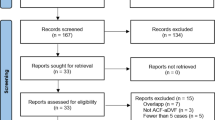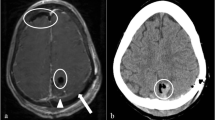Abstract
The decision on whether or not to operate children with Chiari type I malformation (CIM) is difficult and controversial, because of the lack of information about the natural evolution of such a disease. Herein, we report on the evolution of 16 asymptomatic children with incidentally diagnosed CIM (mean age: 6.7 years; mean follow-up: 5.8 years). No patients required suboccipital decompression. Thirteen children remained asymptomatic, with stable or improved radiological picture (worsening in 2 cases). Three cases showed appearance of symptoms: one did not require any treatment; the remaining two underwent endoscopic third ventriculostomy because of hydrocephalus, which is a possible consequence of CIM. This analysis shows a favorable natural outcome of CIM in children, thus suggesting a conservative management in asymptomatic cases. However, multicentric studies are required to validate this data.
Similar content being viewed by others
References
Genitori L, Peretta P, Nurisso C, Macinante L, Mussa F (2000) Chiari type I anomalies in children and adolescents: minimally invasive management in a series of 53 cases. Childs Nerv Syst 16:707–718
Navarro R, Olavarria G, Seshadri R, Gonzales-Portillo G, McLone DG, Tomita T (2004) Surgical results of posterior fossa decompression for patients with Chiari I malformation. Childs Nerv Syst 20:349–356
Haroun RI, Guarnieri M, Meadow JJ, Kraut M, Carson B (2000) Current opinions for the treatment of syringomyelia and Chiari malformations: survey of the Pediatric section of the American Association of Neurological Surgeons. Pediatr Neurosurg 33:311–317
Schijman E, Steinbok P (2004) International survey on the management of Chiari I malformation and syringomyelia. Childs Nerv Syst 20:341–348
Elster AD, Chen MY (1992) Chiari I malformations: clinical and radiological reappraisal. Radiology 183:347–353
Meadows J, Kraut M, Guarnieri M, Haroun RI, Carson BS (2000) Asymptomatic Chiari type I malformations identified on magnetic resonance imaging. J Neurosurg 92:920–926
Kojima A, Mayanagi K, Okui S (2009) Progression of pre-existing Chiari type I malformation secondary to cerebellar hemorrhage. Neurol Med Chir (Tokyo) 49:90–92
Novegno F, Caldarelli M, Massa A, Chieffo D, Massimi L, Pettorini B, Tamburrini G, Di Rocco C (2008) The natural history of the Chiari type I anomaly. J Neurosurg Pediatr 2:179–187
Miller JH, Limbrick DD Jr, Callen M, Smyth MD (2008) Spontaneous resolution of Chiari malformation type I in monozygotic twins. J Neurosurg Pediatr 2:317–319
Nishizawa S, Yokoyama T, Yokota N, Tokuyama T, Ohta S (2001) Incidentally identified syringomyelia associated with Chiari I malformations: is early interventional surgery necessary? Neurosurgery 49:637–640
Tokunaga M, Minami S, Isobe K, Moriya H, Kitahara H, Nakata Y (2001) Natural history of scoliosis in children with syringomyelia. J Bone Jt Surg Br 83:371–376
Javatallabhula NS, Armstrong J, Sgouros S, Whitehouse W (2006) Spontaneous resolution of isolated Chiari I malformation. Childs Nerv Syst 22:201–203
Sun JC, Steinbock P, Cochrane DD (2000) Spontaneous resolution and recurrence of a Chiari I malformation and associated syringomyelia. Case report. J Neurosurg 92:207–210
Conflict of interest
The authors declare that there is no actual or potential conflict of interest in relation to this article.
Author information
Authors and Affiliations
Corresponding author
Rights and permissions
About this article
Cite this article
Massimi, L., Caldarelli, M., Frassanito, P. et al. Natural history of Chiari type I malformation in children. Neurol Sci 32 (Suppl 3), 275–277 (2011). https://doi.org/10.1007/s10072-011-0684-3
Published:
Issue Date:
DOI: https://doi.org/10.1007/s10072-011-0684-3




